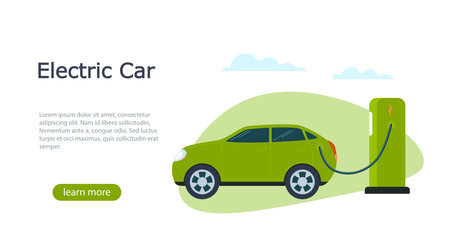Introduction to EV Batteries and Environmental Concerns
Electric vehicles (EVs) are rapidly transforming the American automotive landscape, driven by advancements in technology, environmental awareness, and supportive public policies. At the heart of this transformation lies the lithium-ion battery, a critical component that stores and supplies power to EVs. As the U.S. witnesses exponential growth in EV adoption—fueled by consumer demand and ambitious federal targets—the spotlight increasingly shifts toward the environmental implications of these batteries. While EVs promise significant reductions in tailpipe emissions compared to traditional gasoline vehicles, their batteries present a set of unique sustainability challenges. Key concerns include the extraction of raw materials such as lithium, cobalt, and nickel, the energy-intensive manufacturing processes, and the complex issues surrounding battery disposal and recycling at end-of-life. Understanding these challenges is essential for evaluating whether EVs truly offer a net positive impact on the environment and identifying actionable solutions that can make electric mobility more sustainable for future generations.
2. Resource Extraction and Supply Chain Challenges
The surge in electric vehicle (EV) adoption has intensified global demand for key battery materials such as lithium, cobalt, and nickel. While these resources are critical to advancing EV technology, their extraction and supply chains introduce significant environmental and social challenges. Understanding the full lifecycle impact of these materials is essential to evaluating the true sustainability of EV batteries.
Environmental Impact of Raw Material Sourcing
Mining operations for lithium, cobalt, and nickel are energy-intensive and can cause substantial ecological disruption. Lithium extraction, especially from brine in regions like South America’s “Lithium Triangle,” consumes vast amounts of water, often in arid environments, affecting local agriculture and water availability. Cobalt mining, predominantly centered in the Democratic Republic of Congo (DRC), is associated with deforestation, soil degradation, and hazardous waste generation. Nickel mining also leads to land degradation and pollution due to the use of sulfuric acid in laterite ore processing.
| Material | Main Mining Regions | Key Environmental Concerns |
|---|---|---|
| Lithium | Chile, Argentina, Australia | Water depletion, ecosystem disturbance |
| Cobalt | Democratic Republic of Congo | Deforestation, toxic waste, air & water pollution |
| Nickel | Indonesia, Philippines, Russia | Soil contamination, acid runoff |
Social Implications of Battery Material Mining
The human cost of raw material extraction is a growing concern for both industry leaders and consumers. In cobalt mining communities within the DRC, reports indicate widespread use of child labor and unsafe working conditions. These issues have prompted calls for stricter supply chain transparency and ethical sourcing initiatives across the EV sector.
Sustainable Sourcing Initiatives
The industry response includes efforts to improve traceability through blockchain technology, adherence to international labor standards, and investment in recycling programs to reduce dependence on newly mined materials. Automakers are increasingly partnering with certified suppliers who commit to responsible mining practices and environmental stewardship.
Toward Responsible Supply Chains
The shift toward sustainable sourcing is critical for minimizing the environmental footprint of EVs. By prioritizing responsible procurement policies and supporting technological innovations in battery chemistry that require fewer scarce minerals, stakeholders can address both ecological harm and social injustice within battery supply chains.

3. Manufacturing Footprint and Energy Consumption
Battery manufacturing for electric vehicles (EVs) is a highly energy-intensive process, and its environmental impact is a critical aspect of the overall sustainability equation. The production of lithium-ion batteries requires significant amounts of electricity, often derived from non-renewable sources, which contributes to notable carbon emissions. This is especially relevant in regions where the grid relies heavily on fossil fuels. For instance, studies have shown that battery manufacturing can account for up to 40% of an EV’s total lifecycle greenhouse gas emissions before it even hits the road.
The complexity of battery manufacturing extends beyond just assembling cells; it involves mining, refining raw materials like lithium, cobalt, and nickel, and then processing these elements into battery-grade components. Each step consumes considerable energy and emits greenhouse gases, particularly when supply chains are globalized and transportation distances are long. Additionally, the use of high-temperature processes in cathode and anode production further increases the energy demand.
However, regional differences in energy infrastructure can significantly affect the carbon footprint of battery manufacturing. Plants powered by renewable energy sources such as wind or solar have a much lower environmental impact compared to those dependent on coal or natural gas. American manufacturers are increasingly investing in cleaner energy solutions and more efficient production technologies to address these challenges. Innovations such as closed-loop recycling systems and advanced material recovery also offer pathways to reduce both energy use and emissions during the battery manufacturing phase.
4. Battery Life Cycle: Use, Degradation, and Disposal
The lifecycle of electric vehicle (EV) batteries is a critical factor in understanding their environmental impact and sustainability profile. From initial use through gradual degradation to eventual disposal or repurposing, each phase presents unique challenges and opportunities for both manufacturers and consumers.
Performance Over Time
EV batteries are designed for longevity, but their performance inevitably diminishes over years of charging and discharging cycles. Typically, the usable life of a lithium-ion battery in an EV ranges from 8 to 15 years depending on factors such as usage patterns, climate conditions, and battery management systems. As the battery ages, its ability to hold a charge decreases, leading to reduced driving range—a key concern for American drivers accustomed to long-distance travel.
Common Degradation Issues
| Degradation Factor | Description | Impact on Battery |
|---|---|---|
| Chemical Breakdown | Deterioration of electrode materials over time | Reduced capacity and efficiency |
| Thermal Stress | High or fluctuating temperatures accelerate wear | Shorter lifespan, safety concerns |
| Deep Discharge Cycles | Frequent full drain and recharge cycles | Faster capacity loss |
Handling End-of-Life Batteries
Once EV batteries reach the end of their automotive life—typically when their capacity drops below 70-80%—they enter the disposal or repurposing phase. In the U.S., several practices are emerging to address this challenge:
- Recycling: Specialized facilities recover valuable metals like lithium, cobalt, and nickel, reducing reliance on virgin mining.
- Second-life Applications: Used EV batteries are repurposed for stationary energy storage, supporting renewable integration into the grid.
- Regulatory Compliance: Federal and state regulations are evolving to ensure responsible collection, transport, and processing of used batteries.
Together, these approaches aim to minimize environmental harm while maximizing resource recovery—key priorities for sustainable mobility in the United States.
5. Recycling and Second-Life Applications
As electric vehicles (EVs) become more prevalent in the United States, effective management of end-of-life batteries is emerging as a critical sustainability concern. The environmental impact of EV batteries can be significantly mitigated by advancing recycling technologies and developing second-life applications that extend their useful lifespan.
Evaluation of Emerging Battery Recycling Technologies
Traditional battery recycling methods, such as pyrometallurgical and hydrometallurgical processes, have notable limitations, including high energy consumption and incomplete material recovery. However, recent advancements are addressing these issues. Direct recycling, an innovative approach currently under development, seeks to recover and reuse cathode materials without breaking them down into base elements, improving both efficiency and environmental outcomes. Several pilot projects in the U.S. are demonstrating promising results, with companies like Redwood Materials and Li-Cycle scaling up operations to process lithium-ion batteries at commercial levels. The federal government has also recognized the importance of domestic battery recycling infrastructure, providing funding to accelerate research and commercialization of next-generation recycling facilities.
Repurposing Batteries for Grid Storage and Second-Life Uses
Even after EV batteries lose enough capacity to be inefficient for automotive use, they often retain substantial storage potential. Repurposing these batteries for grid storage helps integrate renewable energy sources, balance supply and demand, and provide backup power during outages—a priority for American utilities facing increasing climate-related disruptions. Major automakers and technology firms are piloting programs that deploy used EV batteries in stationary storage systems for homes, businesses, and grid-scale applications. This not only diverts batteries from landfills but also maximizes resource utilization by extending battery service life beyond transportation.
The Path Forward: Integrating Circular Economy Principles
To fully realize the environmental benefits of EVs, robust collection networks, standardized battery designs, and clear regulatory frameworks are needed to support large-scale recycling and second-life deployment. Collaboration across industry stakeholders—including automakers, recyclers, utilities, and policymakers—is essential to build a circular economy around EV batteries. By prioritizing closed-loop solutions and investing in innovation, the U.S. can reduce reliance on virgin raw materials while minimizing the ecological footprint associated with electric mobility.
6. Policy, Innovation, and the Road Ahead
The United States has been at the forefront of addressing the environmental impact of EV batteries through a multi-faceted approach combining policy initiatives, technological advancements, and collaborative industry efforts. On the policy front, federal and state governments have implemented programs such as the Inflation Reduction Act, which offers tax incentives for EV buyers and encourages domestic battery manufacturing with strict sustainability standards. The Department of Energy’s Battery Recycling Prize and investments in critical minerals sourcing further aim to minimize environmental harm by promoting circular economy principles and reducing dependence on overseas supply chains.
Technological innovation is another cornerstone of progress. American startups and established automakers are investing heavily in next-generation battery chemistries that use less cobalt and nickel—metals often associated with environmental degradation and human rights concerns abroad. Advancements in solid-state batteries promise longer lifespans, improved safety profiles, and easier recyclability compared to conventional lithium-ion cells. Universities and research labs across the U.S. are pioneering scalable recycling techniques that can recover over 90% of valuable materials from used batteries, significantly lowering resource extraction needs.
Industry collaboration is also gaining momentum. Major automotive brands are forming partnerships with battery recyclers to establish closed-loop systems where end-of-life batteries are collected, dismantled, and repurposed into new products or energy storage solutions. Organizations like the Responsible Battery Coalition are setting voluntary sustainability benchmarks while fostering dialogue between manufacturers, policymakers, and environmental groups.
Despite these promising developments, challenges remain. Regulatory harmonization across states, scaling up recycling infrastructure, and ensuring ethical sourcing throughout global supply chains require continued vigilance and investment. Consumer education about proper battery disposal and participation in take-back programs is equally vital to achieve full lifecycle sustainability.
Looking ahead, a coordinated approach—blending robust policy frameworks, relentless innovation, and strong industry stewardship—will be essential to mitigate the environmental footprint of EV batteries as electric mobility becomes mainstream in America. By learning from early successes and addressing ongoing gaps, the U.S. can set a global example for sustainable electrification.


